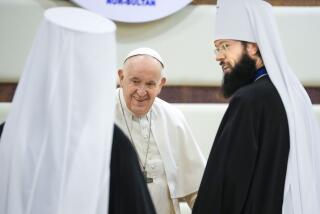A Wild Card: Fundamentalists in the Soviet Bloc
- Share via
WASHINGTON — A religious revival in Eastern Europe is creating unexpected difficulties for the Soviet Union and its satellites. Western commentary has focused on Catholicism: the election of the Polish Pope and his visits to his homeland; striking workers hearing Mass behind the gates of the Lenin Shipyard; the attempt to assassinate the Pope, connected in some now-obscured way with the Bulgarian--meaning Soviet--secret police; the murder by Polish secret police of Father Jerzy Popieluszko; the millions of pilgrims to Medjugorje, a remote Yugoslavian village where children say they saw apparitions of the Virgin Mary.
But this renewed fervor among Roman Catholics parallels rapid growth of fundamentalist Protestantism in the Soviet Union and Romania. In both countries, the hierarchy of the Orthodox Church continues to fill its historical function as the agent of secular power--although that power is now communist.
Throughout the Soviet Bloc, increasing numbers of people, disillusioned by the failed promises of communism, are turning to religion. In the Soviet Union, growing numbers of believers, no longer willing to subject themselves to the chicanery of the “legal” administrative structure, live their religious lives in the catacombs, as do the Uniates, the Orthodox schismatics and ever-larger numbers of Protestant evangelicals.
Accurate figures about the growth of fundamentalism are not available to the West. But eloquent testimony that fundamentalism is the fastest growing religious movement in these two countries is available in the massive “Country Reports on Human Rights Practices,” an annual survey submitted to Congress by the State Department. The report covering 1984 contains evidence that, in the Soviet Union, Pentecostals, Action-Group Baptists and Seventh-Day Adventists are specific targets of judicial and extrajudicial persecution. The situation is similar in Romania. And in these totalitarian states, the level of police attention to a dissident social group is as exact an index as we have of the degree that its target disturbs the autocracy’s rule.
In the Soviet Union, with 250 million people, these obscure Protestant sects number perhaps 3 million people, scattered in tiny congregations across nine time-zones. In Romania they may be 3,000 in a total population of 23 million.
Why, then, do the Soviet leaders and the Ceausescu regime fear them so?
Ultimately, because the communists fear people whom they can control only by incarceration or murder. They believe that every individual has a price and can be cajoled, bribed, blackmailed or brow-beaten into conformity with the state. People prepared to die for their beliefs lie outside the state’s power,
In the area of religion, the Soviet Union’s ambition is to catch up with Albania. In 1967, Albania officially became the world’s first atheist state. The Soviet Union still has a considerable distance to go because, during World War II, Josef Stalin made concessions to the Orthodox Church, as well as to such important minorities as the Jews, in return for support of the war effort.
Church-state detente lasted until 1959, when Nikita S. Khrushchev ordered the resumption of active discouragement of religious life. The new measures led to the closing of thousands of Orthodox churches between 1959 and 1964. This continues today, but at a less dramatic rate.
Closing churches does not mean destruction of belief. When Billy Graham visited the Soviet Union in 1982, he reported churches filled to overflowing. He drew the false conclusion that this was evidence of religious freedom. In fact, there are several times too few churches and too few clergymen to accommodate those who want to worship. Using repressive 1929 legislation, the Soviets compel the Orthodox hierarchy to collaborate in reducing the numbers of churches and clergy. The hierarchy’s subservience has provoked sharp protests from clergymen and lay believers--foremost among them Father Gleb Yakunin, for many years imprisoned and still in exile. This collaboration between the state and the hierarchy has also left the field open to evangelical proselytizers. That is a major reason why evangelical congregations are the most rapidly growing religious groups in the Soviet Union.
In the early 1960s, responding to the new repressions, Baptists formed an Action Group, led by Georgi Vins (now in the United States) and Gennadi Kryuchkov (now underground in the Soviet Union). The Action Group demands the revision of the 1929 legislation that legally enables the state to regulate religious life; thousands of Baptists have been arrested and thousands more suffer harassment.
Young people are prominent among the Action Group Baptists and the Pentacostals. When drafted into the armed forces, many young evangelicals refuse to swear allegiance to an atheist state. For this, they are sentenced to labor camps. Both those who take the oath with hidden reservations and those imprisoned for refusing it are subjected to “reeducation,” often brutally administered.
The danger to sons approaching draft age led seven members of two Pentacostal families to take refuge in the U.S. Embassy in Moscow in 1978. They remained crowded in a small basement room until 1983, when they were allowed to emigrate as the part of the price the U.S. government exacted for a grain-sales agreement.
On Dec. 15, Secretary of State George P. Shultz visited Bucharest, Romania. He told President Nicolae Ceausescu that if his regime does not its moderate repression of fundamentalists, the U.S. Congress may no longer accept State Department assurances that Romania’s human-rights practices meet the standard required for most-favored-nation trade agreements.
At the Geneva summit, however, President Reagan soft-pedaled criticism of Soviet human-rights violations and talked about “quite diplomacy.” He received no quid pro quo for this concession that relieved the Soviet leadership of the only non-economic pressures that could compel some conformance with the Helsinki accords. Both Reagan and Shultz are opposed in principle to using economic pressure to help religious dissidents.
Cries for help from Soviet and Romanian evangelicals directed to fellow Christians in the United States are unanswered. Along with the World Council of Churches and the National Council of Churches, the major fundamentalist groups are intent on maintaining ties with their state-controlled Soviet Bloc counterparts.
In his authoritative study, “Church, State and Opposition in the U.S.S.R.,” Gerhard Simon concluded, “the aim of Soviet religious policy is the destruction of the believing communities from the bottom up, so that finally the facade collapses of its own accord.”
Because so many evangelicals refuse to register and will not collaborate with the communist authorities, they cannot be destroyed from the bottom up. That is why Soviet and Romanian authorities can not cope with them and why fundamentalists remain a growing concern. And that is why their problem should concern Americans who, whatever their religious orientation, hold that people have a right to determine for themselves what to believe.
More to Read
Sign up for Essential California
The most important California stories and recommendations in your inbox every morning.
You may occasionally receive promotional content from the Los Angeles Times.













